BaseMark GUI from RightWare Launches: SoCs Benchmarked
by Brian Klug on January 11, 2011 12:47 AM EST- Posted in
- Smartphones
- BaseMark
- Android
- Mobile
Screenshots and Video
We've put together a screenshot gallery with a few more shots of the feature tests and main 3D UI test. Note that screen tearing in those screenshots comes from the Dalvik debugging tool we use to capture screenshots on Android reading the framebuffer as new frames are loaded. I did my best to select those with relatively minimal tearing, but in person the tests appear fine.
To that extent I've also taken a video of Basemark running once through on our myTouch 4G review unit. It's a little over 15 minutes long for the full run. If you want to skip ahead to the 3D UI test which is pretty demanding, you can find it at the 7:06 mark.
Performance Results
We've got devices spread between Anand, Vivek, and myself that we've collectively run Basemark on. Tests in basemark always run with both graphics rendering API calls enabled and disabled to give us an idea for whether performance is CPU or GPU bound in specific tests, but this doesn't affect score. Scoring in Basemark is simply the geometric mean of all the tests' score values.
These scores aren't normalized by screen resolution, so again differing screen sizes do play a part. The minimum officially supported resolution is technically 800x480 WVGA, however I edited a configuration file on the LG Optimus One to support 480x320 HVGA so we could get a score from there too - the rendering looked just fine.
First up is the overall score (which is again the average taken over all the individual tests):
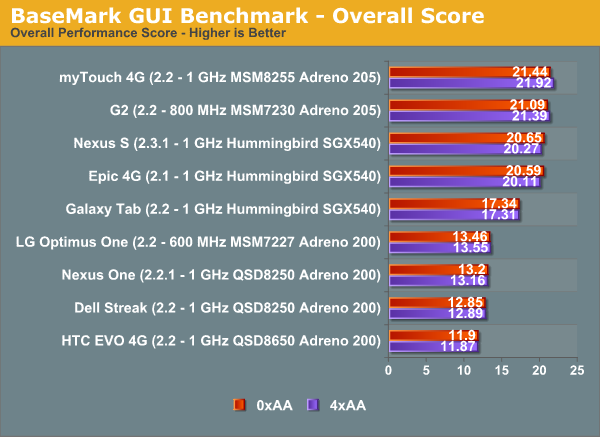
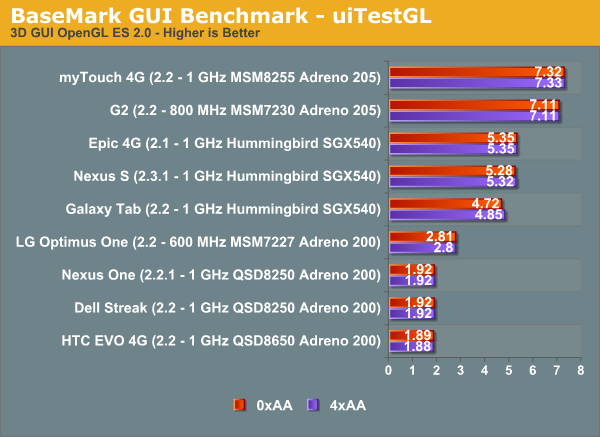
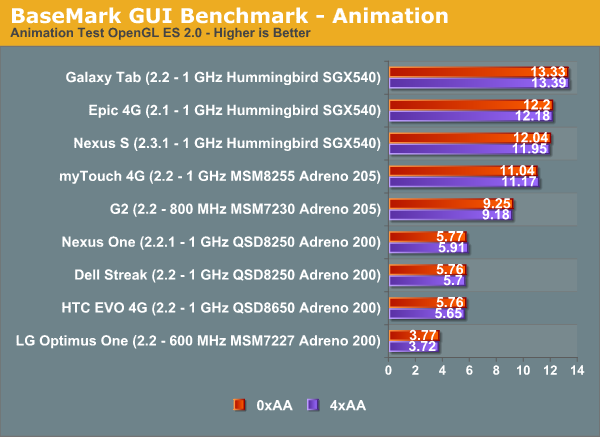
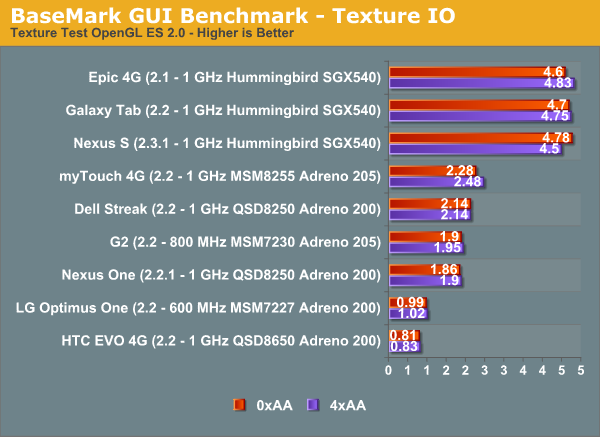
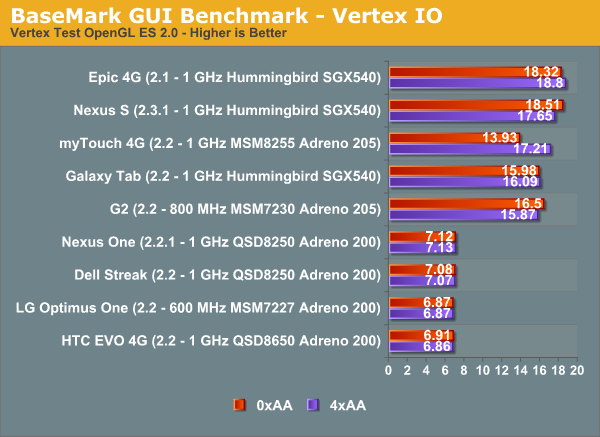
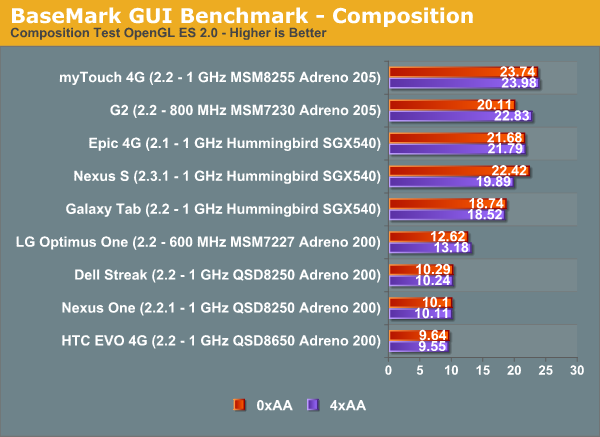
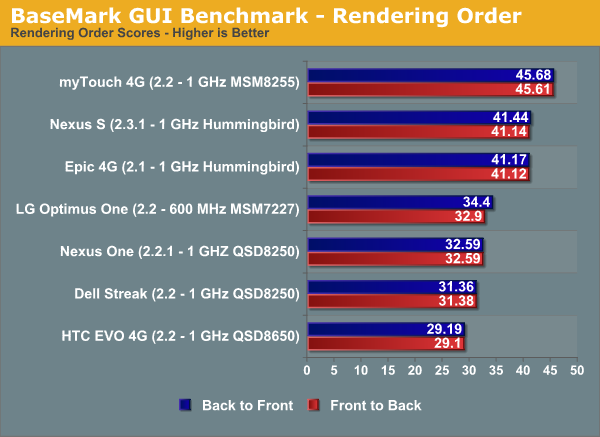
Results here are pretty interesting, and we see the Adreno 205 pull ahead of PowerVR SGX 540 in a few areas, which is surprising considering its substantial lead in our other tests like Quake 3 and GLBenchmark 2. In addition, the results immediately show that 4xAA is essentially free on all these tile-based renderers - results are within the margin of error for virtually all of these tests. Remember that thanks to tile-based rendering, little extra memory bandwidth is required for doing AA here. This is just one of the areas where tile-based architectures shine.
The Nexus S is a bit crashy throughout this benchmark, no doubt due to how new Android 2.3 is, and the Tegra 2 ViewSonic tablet produced strange results inbetween constant crashing, so we discarded its scores. As soon as we get more stable and final hardware, we'll add those Tegra 2 results in a full review. For now however, this is just another tool we're adding to our suite.
















20 Comments
View All Comments
QChronoD - Tuesday, January 11, 2011 - link
Cool article, it's amazing how fast cell phones are getting now.Are they planning on releasing a version that can be run on iOS?
I know that this will probably start a flame war, but I think that's really what Android phones are competing against. There is competition between the different models, but choosing which android phone seems to be a secondary decision, after you've already made the choice not to get an iPhone.
(has an iPhone4 and loves it, has played with a few android tablets but wasn't all that impressed with the UI)
BTW, the music in the video sounds like its from some bad Cinemax soft-core porno
alovell83 - Tuesday, January 11, 2011 - link
Comparing vs the current iPhone wouldn't really be fair to the iPhone due to the processor requiring more power to push the higher resolution.So, I'm not flamming when I say that I'm not impressed with the iPad. I haven't played with a Galaxy Tab, but for my usage other than video/gaming, I know the Galaxy Tab is better for me. I have a Galaxy S phone and the browsing experience is just better, no page refreshes and flash are really big for me. I hate, hate, hate when I open too many web pages in the iPad and it then proceeds to refresh every page that I put into the foreground. Or, when I leave the Safari Browser to do something else and it has to refresh the page.
The first, pre-HC Android tablets didn't have much to offer anyone looking to be impressed. But, Apple has a serious hole to fill if it wants to catch up to HC in terms of browsing, UI, and so many areas other than apps.
marraco - Tuesday, January 11, 2011 - link
Is unfair to cheat the consumer into thinking that by buying a larger screen, he will have the same experience, but on large screen.Who sell the large screen should warn the consumer that it is not completely functional, because do not have all the hardware necessary to use the large screen.
MySchizoBuddy - Tuesday, January 11, 2011 - link
Galaxy Tab review a Pocketable train wreck on Gizmodohttp://gizmodo.com/5686161/samsung-galaxy-tab-revi...
Quotes
This thing is just a mess. It's like a tablet drunkenly hooked up with a phone, and then took the fetus swimming in a Superfund cleanup site. The browser is miserable, at least when Flash is enabled. It goes catatonic, scrolling is laggy, and it can get laughably bad.
abrar - Tuesday, January 11, 2011 - link
isnt it available for public use ? i wanted to test my device ;)abrar - Tuesday, January 11, 2011 - link
How can one subscribe to comments in anandt. articles ?ltcommanderdata - Tuesday, January 11, 2011 - link
In terms of real world usage, I thought Android`s GUI performance was more limited by lack of implementation of GPU acceleration rather than lack of performance on the part of GPUs. As such, is this GUI benchmark actually able to tell you what Android phone will feel faster/smoother in the UI?I`m guessing despite the GUI name of the benchmark, it`s still more of a measure of hypothetical raw GPU performance than GUI performance experienced by the end-user.
Brian Klug - Tuesday, January 11, 2011 - link
"It`s still more of a measure of hypothetical raw GPU performance than GUI performance experienced by the end-user."That's actually exactly how I would characterize BaseMark GUI. RightWare's using "GUI" in the name because they're using their own Kanzi tool's UIs (which they believe are similar to possible future 3D user interfaces), but to that extent it's primarily a 3D benchmark which is why we're interested.
-Brian
TareX - Tuesday, January 11, 2011 - link
Things are looking good for the PSP phone, which has the G2's same SoC....thornburg - Tuesday, January 11, 2011 - link
The distinct lack of Verizon's "Droid" phones, such as Droid 2 and Droid X is a bit disturbing.In fact, there are no Verizon phones at all included in this. Why is that? Actually, aren't these phones only from Sprint and T-Mobile?
Some kind of carrier bias by AT?